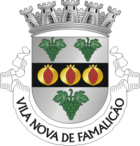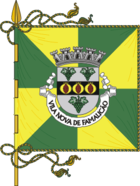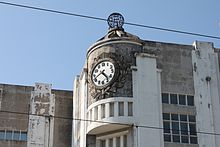Vila Nova de Famalicao
| Vila Nova de Famalicao | ||||||
|---|---|---|---|---|---|---|
|
||||||
| Basic data | ||||||
| Region : | Norte | |||||
| Sub-region : | Cávado | |||||
| District : | Braga | |||||
| Concelho : | Vila Nova de Famalicao | |||||
| Coordinates : | 41 ° 25 ′ N , 8 ° 31 ′ W | |||||
| Residents: | 8480 (as of June 30, 2011) | |||||
| Surface: | 2.2 km² (as of January 1, 2010) | |||||
| Population density : | 3855 inhabitants per km² | |||||
| Postal code : | 4760 | |||||
| District of Vila Nova de Famalicão | ||||||
|
||||||
| Residents: | 133,753 (as of June 30, 2011) | |||||
| Surface: | 201.59 km² (as of January 1, 2010) | |||||
| Population density : | 663 inhabitants per km² | |||||
| Number of municipalities : | 34 | |||||
| administration | ||||||
| Administration address: | Câmara Municipal de Vila Nova de Famalicão Praça Álvaro Marques, 4764-502 Vila Nova de Famalicão |
|||||
| President of the Câmara Municipal: | Armindo Alves Costa ( PSD ) | |||||
| Website: | www.cm-vnfamalicao.pt | |||||
Vila Nova de Famalicão (in everyday life mostly just Famalicão ) is a city in Portugal and it belongs to the Braga district , with 133,753 inhabitants (district, as of June 30, 2011). The renowned director Manoel de Oliveira made a documentary about the city in 1941, which he expressed his sympathy for several times.

The house of Camilo Castelo Branco , now a museum
|
history
Finds from the Castro culture prove a settlement before the arrival of the Romans .

Pedra Formosa by Castro de Eiras
|
In the course of his settlement policy, D.Sancho II re- founded the place in 1205 and gave it its first city rights. The place was as Fhamelicam to 1307 in the registers of the king D.Dinis out and dipped in 1527 for the first time as Vila Nova de Famyliquam on. He always belonged to Barcelos until Queen Maria II established the independent district of Vila Nova de Famalicão in 1835 . The place was raised to a small town ( Vila ) in 1841 .
The place experienced significant development spurts in the further course of the 19th century. The opening of the Porto to Braga road in 1851 and the arrival of the railroad in 1875 favored industrial and, subsequently, general development in the district. The opening of the Hospital da Misericórdia hospital in 1878 and the new town hall in 1881 are evidence of this. In 1863 , the writer Camilo Castelo Branco settled in the district, in the country house Quinta de S. Miguel in silk , where he shot himself in 1890 . Palace-like town houses such as the Palacete Barão da Trovisqueira were built. Several industrial companies settled down, including in 1886 the printing and publishing Minerva or 1892 , the watch factory regulators Dora . A variety of publishers, newspapers and magazines were founded, including Alvorada .
Vila Nova de Famalicão was elevated to a city (Cidade) in 1985 .
Sports
The football club FC Famalicão , founded in 1931, currently plays first-class (2019/2020 season) in the Primeira Liga . He plays his home games in the urban Estádio Municipal 22 de Junho . In the same group, the FC Famalicão meets three other clubs from the Famalicão district, so on
Other clubs in the district are the Grupo Desportivo de Ribeirão , which is based in the municipality of Ribeirão , the football club Grupo Desportivo de Joane from the municipality of Joane , founded in 1930 , the Associação Desportiva Oliveirense (AD Oliveirense) from the municipality of Santa Maria de Oliveira, the lower class playing football club Associação Desportiva Ninense from the municipality of Nine . An important swimming club is the Grupo Desportivo de Natação de Vila Nova de Famalicão .
economy
A large number of industrial companies are active in the district, in particular the textile industry, but also food processing and the like. a. The Portuguese meat producer Primor employs around 400 people here. The Reguladora , founded in 1892, is the oldest watch factory on the Iberian Peninsula and today the only remaining watch manufacturer in the country.
In Vila Nova de Famalicão there has been a factory of the German camera manufacturer Leica with around 600 employees since the first half of the 1970s .
traffic
The city is integrated into the country's rail network via the Linha do Minho line , and also into the suburban train network of Porto via the former Linha da Póvoa . Since 2005, the route has been integrated as the red line B of Metro do Porto into the metro network of the greater Porto area.
The national road N14 has been developed into an expressway here and bypasses the city. The A7 and A3 highways intersect at Famalicão, each with its own exit to the city.
Famalicão is part of the national bus network of Rede Expressos .
administration
circle
Vila Nova de Famalicão is the seat of a district of the same name ( concelho ). The neighboring areas are (starting clockwise in the north): Braga , Guimarães , Santo Tirso , Trofa , Vila do Conde , Póvoa de Varzim and Barcelos .

With the regional reform in September 2013 , several municipalities were merged into new municipalities, so that the number of municipalities decreased from 49 to 34.
The following municipalities ( Freguesias ) are in the district of Vila Nova de Famalicão:
| local community | Population (2011) |
Area km² |
Density of population / km² |
LAU code |
|---|---|---|---|---|
| Antas e Abade de Vermoim | 7,362 | 5.44 | 1,353 | 031250 |
| Arnoso e Sezures | 3,543 | 8.81 | 402 | 031251 |
| Avidos e Lagoa | 2,653 | 4.67 | 568 | 031252 |
| Bairro | 3,598 | 3.35 | 1,073 | 031204 |
| Calls | 2,231 | 2.49 | 896 | 031206 |
| Carreira e Bente | 2,576 | 3.58 | 720 | 031253 |
| Castelões | 2,021 | 3.53 | 573 | 031210 |
| Cruz | 1,738 | 4.13 | 421 | 031212 |
| Delães | 3,917 | 2.46 | 1,590 | 031213 |
| Esmeriz e Cabeçudos | 3,684 | 7.25 | 508 | 031254 |
| Fradelos | 3,914 | 16.80 | 233 | 031215 |
| Gavião | 3,747 | 4.04 | 927 | 031216 |
| Gondifelos, Cavaloes e Outiz | 4,890 | 16.71 | 293 | 031255 |
| Joane | 8,089 | 7.32 | 1.106 | 031219 |
| Landim | 2,834 | 4.51 | 628 | 031221 |
| Lemenhe, Mouquim e Jesufrei | 3,217 | 9.83 | 327 | 031256 |
| Louro | 2,250 | 4.98 | 452 | 031223 |
| Lousado | 4,057 | 5.82 | 697 | 031224 |
| Mogege | 1,943 | 2.87 | 677 | 031225 |
| Nine | 2,974 | 4.34 | 686 | 031227 |
| Pedome | 2.120 | 2.63 | 806 | 031230 |
| Pousada de Saramagos | 2.234 | 2.12 | 1,054 | 031232 |
| Requião | 3,376 | 7.42 | 455 | 031233 |
| Riba de Ave | 3,425 | 2.76 | 1,242 | 031234 |
| Ribeirão | 8,828 | 10.29 | 858 | 031235 |
| Ruivães e Novais | 3,012 | 4.55 | 662 | 031257 |
| Oliveira | 3,420 | 4.52 | 757 | 031239 |
| Vale | 2,081 | 3.60 | 578 | 031241 |
| Oliveira | 2.714 | 2.17 | 1,250 | 031242 |
| Vale, Telhado e Portela | 5,401 | 13.69 | 395 | 031259 |
| silk | 1,542 | 2.85 | 540 | 031258 |
| Vermoim | 2,930 | 4.71 | 622 | 031247 |
| Vila Nova de Famalicão e Calendário | 20,145 | 8.94 | 2,254 | 031260 |
| Vilarinho das Cambas | 1,366 | 8.41 | 162 | 031249 |
| District of Vila Nova de Famalicão | 133,753 | 201.59 | 663 | 0312 |
Population development
| Population in the district of Vila Nova de Famalicão (1849–2011) | ||||||||
|---|---|---|---|---|---|---|---|---|
| 1849 | 1900 | 1930 | 1960 | 1981 | 1991 | 2001 | 2011 | |
| 27,023 | 33,978 | 43,561 | 79,250 | 106.508 | 114,338 | 127,567 | 133,832 | |
Municipal holiday
- June 13th
Town twinning
-
 France : Saint-Fargeau-Ponthierry , in the Seine-et-Marne department
France : Saint-Fargeau-Ponthierry , in the Seine-et-Marne department
-
 Brazil : Caruaru
Brazil : Caruaru
-
 France : Givors
France : Givors
-
 Cape Verde : São Vicente
Cape Verde : São Vicente
-
 Mozambique : Mocuba
Mozambique : Mocuba

sons and daughters of the town

- Tomás Pereira (1645–1708), Jesuit mathematician and scientist, mediator between Europe and China (astronomy, music, politics)
- Francisco Torrinha (1879–1953), philologist and university professor, author of several dictionaries
- Manuel Gonçalves Cerejeira (1888–1977), Archbishop, Cardinal Protopriester and Patriarch of Lisbon
- Cupertino de Miranda (1892–1988), banker and investor
- José Maria Machado de Araújo (1922–2004), writer who was particularly widespread in Brazil
- Antônio Lino da Silva Dinis (1943–2013), Bishop of Itumbiara
- Jorge Ferreira da Costa Ortiga (* 1944), Archbishop of Braga
- Carlos Macedo (* 1946), fado singer
- Paulo Marques (* 1962), rally driver, ten -time Dakar Rally participant (motorcycle and truck)
- Vítor Paneira (* 1966), former soccer player, national player, today coach
- Nuno Melo (* 1966), lawyer and conservative politician, MEP
- Jorge Moreira da Silva (* 1971), engineer and conservative politician, Minister for the Environment, Spatial Planning and Energy
- Cosme Machado (* 1975), football referee
- Quim (* 1975), soccer goalkeeper
- Pedro Soeíro (* 1975), racing cyclist
- Mónica Jorge (* 1978), soccer coach for the women's national team
- António Marcelino Ramos Figueira (* 1978), soccer goalkeeper
- José Carlos Rodrigues (* 1978), racing cyclist
- Tiago Machado (* 1985), racing cyclist
- Ukra (* 1988), football player
- Hugo Ventura (* 1988), soccer goalkeeper
- Ricardo Daniel Antunes Ribeiro (* 1988), football player
- Paulo Oliveira (* 1992), football player
Web links
- Map of the Freguesia Vila Nova de Famalicão at the Instituto Geográfico do Exército
- Official website
Individual evidence
- ↑ www.ine.pt - indicator resident population by place of residence and sex; Decennial in the database of the Instituto Nacional de Estatística
- ↑ a b Overview of code assignments from Freguesias on epp.eurostat.ec.europa.eu
- ↑ www.ine.pt - indicator resident population by place of residence and sex; Decennial in the database of the Instituto Nacional de Estatística
- ↑ History page on the district website , accessed September 11, 2013
- ↑ www.verportugal.net , accessed on August 27, 2013
- ^ Spiegel Online, April 26, 2012, accessed on April 26, 2012
- ^ Publication of the administrative reorganization in the Diário da República gazette of January 28, 2013, accessed on March 16, 2014
- ↑ www.anmp.pt , accessed on September 11, 2013







